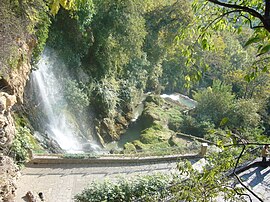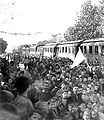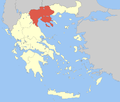| Revision as of 22:04, 18 March 2014 edit87.63.80.142 (talk)No edit summary← Previous edit | Revision as of 22:13, 18 March 2014 edit undoDr.K. (talk | contribs)Autopatrolled, Extended confirmed users, File movers, Pending changes reviewers, Rollbackers110,824 editsm Rv sockNext edit → | ||
| Line 33: | Line 33: | ||
| |elevation_max= | |elevation_max= | ||
| }} | }} | ||
| '''Edessa''' ({{lang-el|Έδεσσα}}, ''Édessa'', {{IPA-el|ˈeðesa|}}), |
'''Edessa''' ({{lang-el|Έδεσσα}}, ''Édessa'', {{IPA-el|ˈeðesa|}}), is a city in northern Greece and the capital of the ], in the ] ] of ]. It was also the capital of the defunct ] of the same name. | ||
| ==Name== | ==Name== | ||
Revision as of 22:13, 18 March 2014
Settlement in Greece| Edessa Έδεσσα | |
|---|---|
| Settlement | |
 Edessa's waterfall. Edessa's waterfall. | |
| Country | Greece |
| Administrative region | Central Macedonia |
| Regional unit | Pella |
| Districts | 15 |
| Government | |
| • Mayor | Dimitris Giannou (ND; since 2011) |
| Area | |
| • Municipal unit | 321.2 km (124.0 sq mi) |
| Elevation | 320 m (1,050 ft) |
| Population | |
| • Total | 18,229 |
| • Municipal unit | 25,179 |
| • Municipal unit density | 78/km (200/sq mi) |
| • Community | 19,036 |
| Time zone | UTC+2 (EET) |
| • Summer (DST) | UTC+3 (EEST) |
| Postal code | 582 00 |
| Area code(s) | 23810 |
| Vehicle registration | ΕΕ |
| Website | dimosedessas.gov.gr |
Edessa (Template:Lang-el, Édessa, Template:IPA-el), is a city in northern Greece and the capital of the Pella regional unit, in the Central Macedonia region of Greece. It was also the capital of the defunct province of the same name.
Name
The name Edessa is probably of Phrygian origin.One scholar considers it to be Illyrian. The Slavic name Vodena is first attested in the 10th century, and became the usual name until the 20th century. Both the Phrygian and the Slavic names are related to water.
Vodena (Βοδενά) was the name used in Greek until 1923, when the ancient name Έδεσσα was revived. The modern Bulgarian and Macedonian name remains Voden (Воден). In Turkish, the city is known as Vodina, and in Aromanian the city is known as either Edessa, Vudena or Vodina.
Seleucus I Nicator named the city of Edessa in Mesopotamia (modern Şanlıurfa, Turkey) after the Macedonian Edessa.
Municipality
The municipality Edessa was formed at the 2011 local government reform by the merger of the following 2 former municipalities, that became municipal units:
- Edessa
- Vegoritida
History

Archaeological remains have been discovered on the site of ancient Edessa, just below the modern city (40°47'48.48"N 22° 3'26.24"E). The walls and the agora have been unearthed so far. A colonnade with inscription in Greek dates from Roman times. The city achieved certain prominence in the first centuries AD, being located on the Via Egnatia. From 27 BC to 268 AD it had its own mint. St. Vassa and her three children were put to death in the 3rd century AD.

| |
| O: laureate draped and cuirassed bust | R: Roma seated on shield holding Victory is crowned with a wreath by city goddess Edessa holding cornucopia
EΔECCAIΩN / OMONOI / A |
| bronze coin struck by Philip the Arab in Edessa 244-249 AD; ref.: Moushmov 6277 Plate XLIV 21 | |
Very little is known about the fate of the city after 500 AD. Its bishop Isidore participated in the Ecumenical Council of 692.
The city disappears from the sources thereafter, and re-emerges only in the 11th century, in the account of the Bulgarian wars of Emperor Basil II by John Skylitzes, with the Slavic name Vodena (τὰ Βοδηνά), commonly held to derive from the Slavic word for "water". The Bulgarian historian Vasil Zlatarski hypothesized that it was Vodena, and not Vidin on the Danube, that was a base of the Cometopuli in their revolt against Byzantium.
Little is known about the town under Byzantine rule. Due to its strategic location, controlling the Via Egnatia as it enters the Pindus mountains, the town was much fought over in the subsequent centuries: the Normans under Bohemond I captured it briefly in 1083, the Nicaean emperor John III Vatatzes in 1253, while in the mid-14th century its possession was disputed between the Byzantines and the Serbs under Stephen Dushan, with the latter securing its possession in January 1351. The city was for some time under control of Radoslav Hlapen who gave it as dowry to his son-in-law Nikola Bagaš probably around 1366—7. The city remained in Bagaš's hands at least until 1385. It fell to the Ottoman war leader Evrenos Bey in the late 14th century, along with the rest of Macedonia.
During the Ottoman rule, the Turkish component of the town steadily increased. From the 1860s onwards, the town was a flashpoint for clashes between Greeks and Bulgarians.
After more than 500 years of Ottoman rule, Edessa passed to Greek rule during the First Balkan War on 18 October 1912. At that time, it was already well on its way to becoming a major industrial center in Macedonia. Four large textile factories were in operation by 1914, employing the abundant waterfalls as a source of energy. Prior to World War I, in addition to Greeks, the region of Edessa was also populated by Turks, Bulgarians, Pomaks and Vlachs, but during the population exchange between Greece and Turkey most of the Turks and Pomaks living in Edessa were transferred to Turkey. Large numbers of Greek refugees from Asia Minor were settled in the area in 1923. The population swelled from 9,441 to 13,115 in the 1920s. A large segment of the population specialized in silk production, allowing Edessa to enjoy a high standard of living in the interwar period (1922–1940).
The town suffered during the last days of German occupation of Greece in 1944. As a retaliation for the shooting of one soldier by resistance fighters, the Nazis set Edessa on fire. Half of the city, including the Cathedral and the First Primary School, was destroyed and thousands of people were left homeless.
For most of the Greek Civil War Edessa was under the control of the communist. The Slavic-Macedonian National Liberation Front, later simply the National Liberation Front or NOF was heavily established in the area. By 1946, eleven Slav Macedonian partisan units were operating in the Edessa area. The NOF had a regional committee based in Edessa, but the city continued to be ruled by the national government. When the NOF merged with the Democratic Army of Greece (DSE), many Slav Macedonians in the region enlisted as volunteers in the DSE. After the end of war in 1949, many pro-communists were evacuated or fled to Yugoslavia and the Eastern Bloc.
In the post-war period Edessa gradually lost its competitive advantage in industry and declined economically and in population. Currently there are no major industry at the town. At the beginning of the 21st century, it is a city based on services (mostly linked to its function as capital of the Pella regional unit) and tourism due to the waterfalls and winter sports.
Demographics



| Historical populations | |||
|---|---|---|---|
| (Statistics, 1913-2001) | |||
| Year | Town | Municipal unit | Municipality |
| 1913 | 8,846 | - | - |
| 1920 | 9,441 | - | - |
| 1928 | 13,115 | - | - |
| 1940 | 12,000 | - | - |
| 1951 | 14,940 | - | - |
| 1961 | 15,534 | - | - |
| 1971 | 13,967 | - | - |
| 1981 | 16,642 | - | - |
| 1991 | 17,659 | 25,051 | - |
| 2001 | 18,253 | 25,619 | - |
| 2011 | 19,036 | 25,179 | 28,814 |
Communications
Television
Notable people
- Aggelis Gatsos (1771–1839), fighter in the Greek War of Independence
- Minas Minoidis, Greek scholar
- Vangel Ajanovski-Oče (1909–1996) - secretary of SNOF
- Marietta Chrousala (1983 - ) - fashion model and television presenter
- Georgi Ajanovski (1940 - ) - Slav Macedonian journalist
Twin cities
Gallery
-
 Military lodgings of ancient Edessa
Military lodgings of ancient Edessa
-
 Crowd celebrating the liberation of Edessa (First Balkan War)
Crowd celebrating the liberation of Edessa (First Balkan War)
- Monument for the Greek civil war Monument for the Greek civil war
-
 Folklore museum
Folklore museum
-
Metropolis
See also
- List of settlements in the Pella regional unit
- Edessa Ecclesiastical Museum
- Folklore Museum of Edessa
Further reading
- F. Papazoglou, Les villes de Macédoine romaine (The Cities of Roman Macedonia), BCH Suppl. 16, 1988, 127-131.
- Walter Bauer, Orthodoxy and Heresy in Earliest Christianity, 1934, (in English 1971) (On-line text)
References
- "Απογραφή Πληθυσμού - Κατοικιών 2011. ΜΟΝΙΜΟΣ Πληθυσμός" (in Greek). Hellenic Statistical Authority.
- N.G.L. Hammond, "The Literary Tradition for the Migrations", in The Cambridge Ancient History II.2B:710 1975
- Hammond N.G.L, A history of Macedonia, Historical geography and prehistory, Vol. 1, Oxford 1979
- Ulrich Wilcken, Alexander the Great, p. 23
- Paul Hellander, Greece, Lonely Planet, 2008, p. 302
- cf. Geographical name changes in Greece
- Kallikratis law Greece Ministry of Interior Template:El icon
- ^ Browning, Robert; Kazhdan, Alexander (1991). "Vodena". In Kazhdan, Alexander (ed.). The Oxford Dictionary of Byzantium. Oxford and New York: Oxford University Press. p. 2185. ISBN 978-0-19-504652-6.
-
 Chisholm, Hugh, ed. (1911). "Vodena". Encyclopædia Britannica (11th ed.). Cambridge University Press.
Chisholm, Hugh, ed. (1911). "Vodena". Encyclopædia Britannica (11th ed.). Cambridge University Press.
- Зборник радова Византолошког института. Научно дело. 1987. p. 219.
... свакако пре 1366/7 ...указана је могућност да га је Хлапен одмах након тога уступио Николи Багашу, ожењеном једном од његвих кћери..
- Зборник радова Византолошког института. Научно дело. 1987. p. 164.
- Vacalopulos, Konstandinos A. Modern history of Macedonia, Thessaloniki 1988, p. 52, 57, 64
- Simpson, Neil (1994). Macedonia Its Disputed History. Victoria: Aristoc Press, 105,106 & 94. ISBN 0-646-20462-9.
- "Les Archives de la Macedoine, Fond: Aegean Macedonia in NLW" - (Field report of Mihail Keramidzhiev to the Main Command of NOF), 8 July 1945
- Η Τραγική αναμέτρηση, 1945-1949 – Ο μύθος και η αλήθεια. Ζαούσης Αλέξανδρος" (ISBN 9607213432).
- Simpson, Neil (1994). Macedonia Its Disputed History. Victoria: Aristoc Press, 101,102 & 91. ISBN 0-646-20462-9.
- "Edessa - 3000 years history". Edessacity.gr. Retrieved 2013-03-26.
- Επίτομο Γεωγραφικό Λεξικό της Ελλάδος (Geographical Dictionary of Greece), Μιχαήλ Σταματελάτος, Φωτεινή Βάμβα-Σταματελάτου, εκδ. Ερμής, ΑΘήνα 2001
External links
- Edessa official site
- Infosite about Edessa
- Pella Prefecture official site, containing useful information about Edessa
- Hellenic Ministry of Culture: Old Cathedral of Edessa
| Administrative division of the Central Macedonia Region | ||
|---|---|---|
| ||
| Regional unit of Chalkidiki |  | |
| Regional unit of Imathia | ||
| Regional unit of Kilkis | ||
| Regional unit of Pella | ||
| Regional unit of Pieria | ||
| Regional unit of Serres | ||
| Regional unit of Thessaloniki | ||
| ||
| Subdivisions of the municipality of Edessa | |
|---|---|
| Municipal unit of Edessa | |
| Municipal unit of Vegoritida |
|